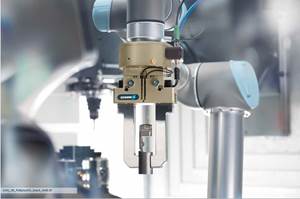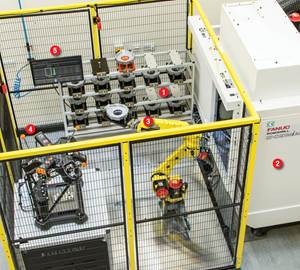Rethinking Robot Anatomy
Actuator-based models offer alternative robot designs.
Share






We all know what an industrial robot looks like. It looks vaguely like a human arm. That is, the typical robot used in a machine shop’s machine tending application has pivots near the base that work somewhat like a human shoulder, a pivot along the length that resembles an elbow and a pivot near the gripper that resembles a wrist. The design also has two long links in the way that a human has an upper and lower arm. A study of our own limbs, it seems, influenced the design of these machines.
However, a robot doesn’t have to look this way. A couple of models from robot supplier Motoman (West Carrollton, Ohio) illustrate alternatives.
The images at left show a seven-axis robot that uses actuator-driven motion. With the seven axes of programmable motion, and with the shorter links, this robot moves more like a snake or tentacle as opposed to a human arm. Standing upright, this robot occupies a footprint just slightly larger than 1 square foot. In fact, it can stand in this footprint close beside a machine tool—or close between two machines—and snake around into the machine’s work zone as needed. This configuration leaves the floor space fully open both in front of the machine and behind it.
The use of actuators permits such a compact form. An actuator is a motion-control device that integrates motor, encoder, reducer and brake into a single body. Normally, these would be separate elements of the robot design, and an important advantage of this established design is power. Robots with separate motors can handle very heavy parts. By contrast, the limitation on the actuator-based robot is how much torque an actuator can deliver. The actuator-based robot is therefore flexible, compact and unobtrusive, but at present it is limited to payloads of 20 kg.
Another actuator-based robot is the dual-arm robot shown on the next page. This 13-axis robot has two six-axis arms, and it works within a footprint comparable to the working space of a human being. In fact, this robot arguably does resemble a human being—except that its two arms work independently in ways no human’s two arms ever could.
Having two independently programmable arms on a robot can dramatically simplify a machine-tending application, because many such applications require complex dual-gripper mechanisms to let a single arm exchange two parts quickly. With two arms working together, simple grippers can accomplish the same quick exchange.
Tom Sipple is the handling products technology leader for Motoman. He says that he and other engineers like him are working to better understand all of the applications in which a dual-arm robot might be applied more effectively than a single arm. Conventional robots are well accepted now, but he predicts that in 10 years, dual-arm robots will also be commonplace. He says one clue that a dual-arm robot may be appropriate in a machining application is when the robot itself is the limiting factor on the cycle time of the overall process. He offers these examples of machine-tending applications where dual-arm robots have proven to be effective:
- Loading a transfer machine. On a high-volume, high-productivity machine such as a dial index machine, the two arms can work simultaneously to unload the finished part while loading the next blank.
- Loading related machines. With the robot between two machine tools (a lathe and a machining center, for example), arm number 1 can hand off the partially machined part to arm number 2. Arm 2 can then load that part in the second machine while arm 1 goes to load the next unmachined part in the first machine.
- Deburring or inspection. While the robot waits for a machining cycle to finish, the two arms can work together to perform a simple operation on a part that has just been machined. Specifically, one arm can hold the part while the other uses a deburring tool or a gage.
- Quick part exchange in small machines. The work zones of some machine tools are so restricted that they don’t even offer clearance for dual-gripper devices on a single arm. For machines such as these, dual arms introduce a way to unload one part and load the next part in a significantly shorter span of time.
Related Content
Cutting Part Programming Times Through AI
CAM Assist cuts repetition from part programming — early users say it cuts tribal knowledge and could be a useful tool for training new programmers.
Read MoreLean Approach to Automated Machine Tending Delivers Quicker Paths to Success
Almost any shop can automate at least some of its production, even in low-volume, high-mix applications. The key to getting started is finding the simplest solutions that fit your requirements. It helps to work with an automation partner that understands your needs.
Read More3 Ways Artificial Intelligence Will Revolutionize Machine Shops
AI will become a tool to increase productivity in the same way that robotics has.
Read More5 Stages of a Closed-Loop CNC Machining Cell
Controlling variability in a closed-loop manufacturing process requires inspection data collected before, during and immediately after machining — and a means to act on that data in real time. Here’s one system that accomplishes this.
Read MoreRead Next
AMRs Are Moving Into Manufacturing: 4 Considerations for Implementation
AMRs can provide a flexible, easy-to-use automation platform so long as manufacturers choose a suitable task and prepare their facilities.
Read MoreLast Chance! 2025 Top Shops Benchmarking Survey Still Open Through April 30
Don’t miss out! 91ÊÓƵÍøÕ¾ÎÛ's Top Shops Benchmarking Survey is still open — but not for long. This is your last chance to a receive free, customized benchmarking report that includes actionable feedback across several shopfloor and business metrics.
Read MoreMachine Shop MBA
Making Chips and 91ÊÓƵÍøÕ¾ÎÛ are teaming up for a new podcast series called Machine Shop MBA—designed to help manufacturers measure their success against the industry’s best. Through the lens of the Top Shops benchmarking program, the series explores the KPIs that set high-performing shops apart, from machine utilization and first-pass yield to employee engagement and revenue per employee.
Read More






















